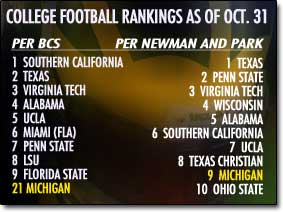Two U-M physicists have devised a new way to rank college football teams that is fast and easy for fans to understand.
Mark Newman, associate professor of physics, and Juyong Park, a doctoral student and rabid Wolverine fan, based the system on the mathematics of networks. It agrees largely with the results of the current oft-criticized Bowl Championship Series (BCS) system used to rank college football teams since the 1998 season.
It differs, however, in several key, controversial areas, says Newman, who isn’t a football fan and admits he’s even passed on tickets to the Big House.

The controversy in the BCS rankings arises because in a single season not all teams play one another and the results of different games can be contradictory, Newman says. To arrive at a set of rankings, the BCS system combines the results of two human polls and four computer algorithms with the top two teams in the rankings playing in the championship game.
Some details of the BCS methodology never have been revealed to fans, which is frustrating, Newman says, and even more so when disagreement arises over the rankings and who earns a spot in the championship game. For instance, this year, five teams were unbeaten as of Oct. 30—USC, Texas, Virginia Tech, Alabama and UCLA.
So which team is the best? According to the U-M method, of the five unbeaten teams Texas ranks as the best, followed by Virginia Tech, Alabama, USC and UCLA.
To test their algorithm, Newman and Park compared all of the top teams ranked by BCS since its inception one year after U-M claimed a share of the 1997 national title.
“Overall we agreed quite closely with standard rankings, especially at the top,” Newman says. “In cases where we differed we found we agreed more closely with the computer polls than with the human judges.
“What we like about our method is it’s very simple,” he says. “The fans would like to understand how the selection is made.”
According to the U-M formula, if A beats B, and B beats C, then A also beats C. The system automatically takes into account strength of schedule, with teams getting direct wins by beating a team and indirect wins by beating a team that beat another team.
“A direct win gets you the most and an indirect win is one step removed and gets you less and so forth,” Newman says. The ranking is based on the sum of the direct and indirect wins and can be used at the beginning or the end of the season, or throughout.
“We found a rule of thumb which allows you to figure out how much to discount indirect wins, which allows you to make evaluations of the season as the season progresses,” Newman says. “Once you have the schedule of games set, you can choose the value of an indirect win.”
Newman and Park also calculated the current season’s rankings, as of Oct. 31. Texas, which has settled back into the No. 2 spot in the BCS after briefly taking over the top spot two weeks ago, was No. 1, followed by Penn State, Virginia Tech, Wisconsin and Alabama. USC, which has topped the BCS rankings most of the year, was No. 6 in the U-M poll. The Wolverines are not far behind at No. 9.
“In this ranking, Big Ten teams are doing quite well, while Southern California, supposedly the strongest team right now, is ranked lower than other polls,” Park says. “We’re only in the middle of the season and we will have to see how everything plays out toward the end, but I find that still interesting because Southern California and the rest of the Pac-10 Conference are really thought to have a pretty weak schedule, while Big Ten teams are the opposite.
“We also see that U-M [at No. 9 before last weekend’s games] has apparently gotten some boost from beating Penn State (No. 2), but maybe not too much damage from being beaten by Wisconsin (4), Notre Dame (22) and Minnesota (19)—all top-25 teams,” Park says.
“This is precisely how our method works—winning against a strong opponent helps you a lot, but losing against a strong opponent doesn’t hurt too much.”

